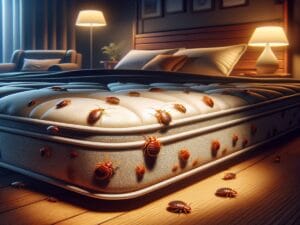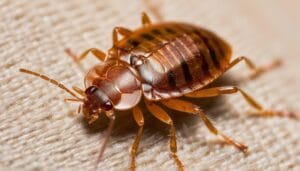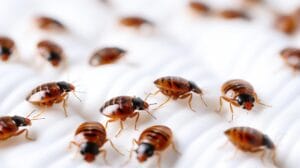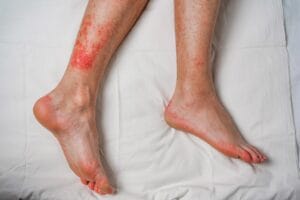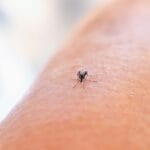When it comes to maintaining a comfortable and safe home, few things are as unsettling as the thought of bed bugs. These tiny, elusive pests can cause a great deal of distress with their itchy bites and rapid spread. But fear not, with the right knowledge and tools, you can detect and manage a bed bug infestation effectively. Here’s how to start.
Key Takeaways
- Early detection of bed bugs is crucial for effective management and elimination.
- Look for physical signs such as small, reddish-brown bugs, shed skins, and tiny, dark stains on bedding or furniture.
- Regular inspections of potential hiding spots can help you catch an infestation early.
- If you suspect bed bugs, use tools like a flashlight and a credit card to inspect crevices and seams.
- For extensive infestations, professional pest control services are recommended to ensure complete removal.
Spot the Signs: Early Detection of Bed Bugs
Most importantly, knowing what to look for is the first step in identifying a bed bug problem. These pests are masters of hiding, so you’ll need to pay close attention to specific indicators that could signal their presence.
Physical Indicators of Bed Bugs in Your Home
Start by looking for the bugs themselves. Adult bed bugs are about the size of an apple seed, reddish-brown, and oval-shaped. Besides live bugs, other tell-tale signs include:
- Small blood stains on your sheets or pillowcases, which could be the result of crushed bugs.
- Dark or rusty spots of bed bug excrement on sheets, mattresses, bedclothes, and walls.
- Fecal spots, eggshells, or shed skins in areas where bed bugs hide.
- An offensive, musty odor from the bugs’ scent glands, especially if the infestation is large.
Behavioral Cues: What Changes to Look Out For
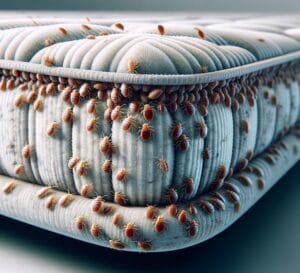
Bed bugs are primarily nocturnal, so you might not see them in action. However, there are changes you can watch for that suggest their presence:
- Unexplained bites, often in a line or cluster, that appear after sleeping.
- Increased itching and discomfort at night, when bed bugs are most active.
- Family members or pets showing similar bite patterns or signs of distress.
Remember, bed bugs can hide in many places, not just your bed. Check seams of chairs and couches, between cushions, in the folds of curtains, and in drawer joints. Even items like electronics and appliances aren’t off-limits to these pests. For more detailed information, read our bed bug identification guide.
DIY Bed Bug Inspection Guide
Now that you know what signs to look for, let’s dive into how you can conduct a thorough inspection of your home.
Step-by-Step Home Inspection
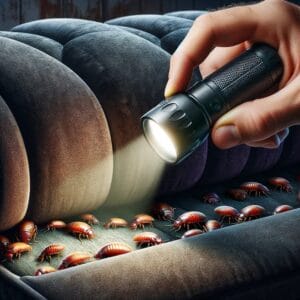
Grab a flashlight and a credit card or another thin, flat tool to help you probe into tight spaces. For more detailed guidance, follow these spring pest-proofing steps:
- Start with your bed. Strip it down to the bare mattress and stand it up to inspect the seams, tags, and any holes or rips.
- Check the box spring, focusing on the corners and where the fabric is stapled to the wood frame.
- Move on to the bed frame and headboard, especially if they’re made of wood or have many crevices.
- Examine bedside furniture, particularly within drawers and along joints.
- Inspect any wall hangings, like picture frames or posters, as bed bugs can hide behind them.
- Don’t forget to look behind peeling wallpaper, electrical outlets, and baseboards.
Be systematic and thorough. Bed bugs are small and can fit into spaces as thin as a credit card, so leave no potential hiding place unchecked.
What Tools Can Help in Detection

Besides a flashlight and credit card, you might find these tools helpful:
- A magnifying glass to identify bed bugs and their eggs more easily.
- Sticky tape or glue boards placed around the bed can catch wandering bugs.
- A vacuum with a crevice tool to suck up any bugs or eggs you find during inspection.
- Ziplock bags to seal off any infested items until they can be treated or disposed of.
After your inspection, if you’ve found evidence of bed bugs or if you’re still suspicious, it’s time to consider professional help.
Hiring a Pest Control Professional
Bed bug infestations can be stubborn and challenging to eliminate. Therefore, if your DIY inspection turns up a problem or if you’re in over your head, it’s wise to call in the pros.
When to Call an Expert
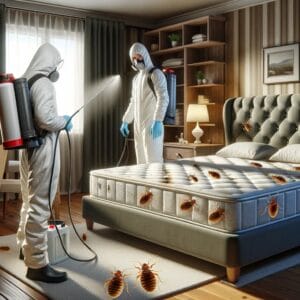
Here are some signs that you need professional intervention: If you notice a persistent presence of pests and traditional home remedies are not working, it might be time to seek out effective natural pest control solutions.
- You found bed bugs in multiple areas of your home.
- Home treatments have failed to control the problem.
- You or your family members are experiencing severe or allergic reactions to bites.
- The thought of dealing with pests is causing you stress or anxiety.
Remember, the sooner you address the issue, the better. Waiting can allow the bed bugs to multiply and spread, making the problem more difficult—and more expensive—to solve.
Stay tuned for more detailed steps on how to keep bed bugs at bay, tackle an infestation, and ensure they don’t return. You’ll learn about preventive measures, non-chemical and chemical treatments, and how to maintain a bed bug-free home long after the pests have been eradicated.
How to Choose the Right Pest Control Service
Choosing the right pest control service is critical when facing a bed bug infestation. Look for a reputable company with experience specifically in bed bug extermination. They should offer a clear plan of action and a follow-up strategy. Make sure they are licensed and ask for references or read online reviews to gauge their reliability. A good service will also help educate you on how to prevent future infestations.
When contacting services, ask about their methods. Some companies may use heat treatment, which is highly effective at killing bed bugs at all life stages, while others may prefer chemical treatments. Discuss any safety concerns, especially if you have children or pets. Lastly, compare warranties and ensure there’s a clear policy for follow-up visits if the bed bugs persist.
Preventative Strategies to Keep Bed Bugs at Bay
Prevention is always better than cure. To keep these unwelcome guests out of your home, you need to adopt some proactive strategies. Let’s explore some measures you can take to prevent bed bugs from settling in.
Mitigating Risks During Travel
Travel is one of the most common ways to bring bed bugs into your home. When staying in hotels, always inspect the bed, furniture, and luggage stands before settling in. Use luggage racks to keep your bags off the floor and away from the bed. When you return home, immediately wash all your clothes in hot water and vacuum your suitcase before storing it.
Maintenance Routines for Bed Bug Prevention
Regular home maintenance can go a long way in preventing bed bug infestations. Vacuum your home frequently, paying special attention to carpets, furniture, and any cracks or crevices. Declutter to minimize hiding spots for bed bugs. Consider using protective covers on mattresses and pillows, which not only prevent bed bugs from entering but also make it easier to spot an infestation.
Elimination Tactics: How to Get Rid of Bed Bugs
If you’ve detected bed bugs in your home, it’s time to take action to eliminate them. Here are some steps you can take to tackle the infestation head-on.
Non-Chemical Approaches
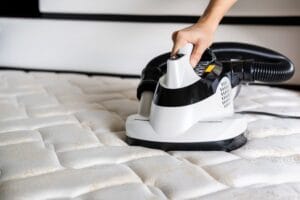
There are several non-chemical methods to control bed bugs:
- Heat treatment: Bed bugs die when exposed to temperatures above 120°F (49°C) for an extended period. Washing bedding and clothing at high temperatures can kill bed bugs and their eggs.
- Vacuuming: A thorough vacuuming of your home can remove bed bugs from surfaces. Be sure to dispose of the vacuum bag in a sealed trash bag immediately after.
- Steam cleaning: Steam can penetrate into fabrics and cracks, killing bed bugs on contact with high temperatures.
- Freezing: While less practical, bed bugs can also be killed by exposing infested items to freezing temperatures for several days.
Remember, while these methods can be effective, they often need to be combined with other treatments to fully eradicate an infestation.
Insecticide Options and Safe Application
Chemical treatments can be a powerful weapon against bed bugs, but they must be used with caution. Always follow the label’s instructions and consider the following:
- Use EPA-registered bed bug products and look for chemicals like pyrethrins, pyrethroids, and desiccants.
- Apply insecticides carefully in targeted areas where bed bugs hide, avoiding broad applications.
- Never use a product indoors that’s intended for outdoor use, as it can be dangerous to your health.
- Consider the safety of children and pets when applying any chemical treatments.
Because improper use of insecticides can lead to health hazards and may even cause bed bugs to scatter and spread, it’s often recommended to leave chemical treatments to the professionals.
Post-Elimination: Ensuring Bed Bugs Stay Gone
After you’ve tackled a bed bug infestation, the last thing you want is a repeat occurrence. Here’s how to ensure your home remains pest-free.
Follow-Up Inspections and Measures
Regular follow-up inspections are key to preventing another infestation. Check the previously affected areas and surrounding spaces every few weeks. Look for signs of bed bugs, and if you spot any, take immediate action. Keeping up with preventive measures, such as vacuuming and reducing clutter, will also help keep your home clear of bed bugs.
Monitoring tools like bed bug interceptors can be placed under the legs of furniture to catch bed bugs trying to climb up from the floor. These tools not only help detect the presence of bed bugs but also serve as a line of defense.
When to Update Your Elimination Strategy
If you notice new signs of bed bug activity after treatment, it may be time to update your elimination strategy. This could involve repeating certain treatments, introducing new methods, or calling in a professional if you haven’t already. Bed bugs are resilient, and it often takes multiple approaches to completely get rid of them.
Remember, bed bug control is a marathon, not a sprint. It requires vigilance, persistence, and sometimes the courage to seek help when needed. By following these tips and staying informed, you can keep your home comfortable and bed bug-free.
Frequently Asked Questions
It’s natural to have questions when dealing with a pest as tricky as bed bugs. Let’s tackle some of the most common queries to give you a clearer understanding and peace of mind.
Can Bed Bugs Transmit Diseases?
One of the few pieces of good news about bed bugs is that they are not known to transmit diseases to humans. While their bites can cause itching and discomfort, and in some cases, allergic reactions, there’s no evidence that they spread pathogens like some other pests do.
How Often Should I Inspect My Home for Bed Bugs?
Regular inspections are key in preventing a full-blown infestation. It’s wise to do a thorough check every few months, or more frequently if you travel often or have guests staying over. Always inspect your home after you or someone else has traveled, especially if you’ve stayed in hotels or hostels.
Can I Use Regular Bug Spray for Bed Bugs?
Most regular bug sprays are not effective against bed bugs. These pests require specific treatments. Look for products that are specifically labeled for bed bug eradication, and make sure to follow the instructions carefully. When in doubt, consult a professional for the safest and most effective approach.
Why Are Bed Bugs Harder to Detect During the Day?
Bed bugs are nocturnal, which means they are most active at night. During the day, they hide in dark, secluded areas to avoid detection. This is why thorough inspections are necessary, as bed bugs can easily go unnoticed to the untrained eye.
What Should I Do with My Bedding After a Bed Bug Infestation?
After dealing with bed bugs, you’ll need to clean your bedding thoroughly. Wash all sheets, pillowcases, and blankets in hot water and dry them on the highest dryer setting. For items that can’t be washed, consider using a steamer or placing them in a sealed bag and leaving them in the sun for a few days to kill any remaining bugs.
Remember, dealing with bed bugs can be stressful, but it’s a challenge you can overcome with the right approach and persistence. Keep your home clean, stay vigilant, and don’t hesitate to call in professional bed bug exterminators if the situation calls for it. With these tips, you can detect, prevent, and eliminate bed bugs, ensuring your home stays a comfortable and pest-free haven.
Option A.
